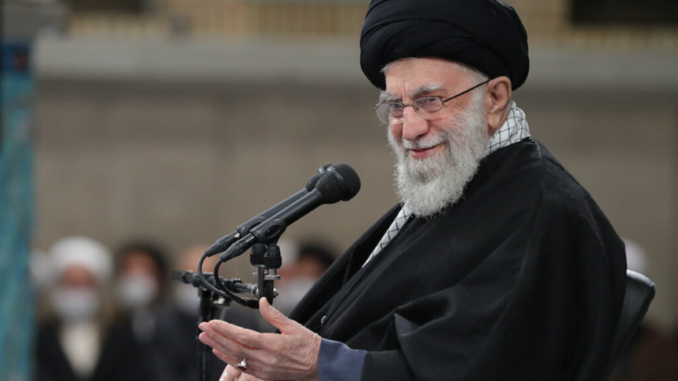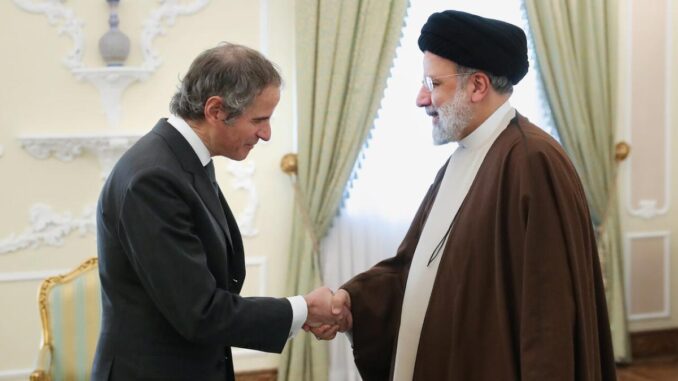By Yigal Carmon and A. Savyon, MEMRI
 Iranian supreme leader Ali Khamenei
Iranian supreme leader Ali Khamenei
Joint Chiefs of Staff chairman General Mark Milley recently told Congress: “Iran could produce fissile material for a nuclear weapon in less than two weeks, and would only take several more months to produce an actual nuclear weapon.”
Despite the economic sanctions against it, Iran continues its efforts towards enrichment of weapons-grade uranium.[1]
This demands immediate action on the part of the West, and such action was about to be taken at the International Atomic Energy Agency Board of Directors meeting on March 6-9, 2023. Joint Chiefs of Staff chairman General Mark Milley recently told Congress: “Iran could produce fissile material for a nuclear weapon in less than two weeks, and would only take several more months to produce an actual nuclear weapon.”[2]
Ahead of the meeting, Iran found itself in a difficult situation. On top of the pending IAEA resolution against it, Chinese President Xi Jinping’s visit to Saudi Arabia and his support for the UAE with regard to the disputed islands in the Persian Gulf hurt Iran’s status in the region. On the domestic scene, it has been dealing with an intense national, social, and ethnic anti-regime revolt for several months. In addition, its economic situation deteriorated significantly, primarily as a result of the Western sanctions.
In order to extricate Iran from its predicament, Supreme Leader Ali Khamenei took a series of strategic steps. With regard to the pending IAEA decision, all it took to deter the IAEA and the West from confronting Iran for its violations of Code 3.1 of the NPT Safeguards and of the JCPOA was a public threat[3] to “cut off the hands” of the West[4] and to make ambiguous promises to cooperate with the IAEA.[5] As a result, a concrete resolution against Iran was postponed by four months until the next Board meeting. In doing so, the IAEA practically accepted Iran’s enrichment of uranium to 60%, which constitutes a blatant violation of the JCPOA.
Much more significant was the historic, far-reaching political move initiated by Iran: the agreement to renew diplomatic relations with Saudi Arabia. This had the triple effect of increasing the status of China – which brokered the deal – in the region, of dealing a powerful blow to America’s status in the region, and of enabling Iran to present itself as a regional peacemaker.
Iran’s Islamic regime had to show that it was compromising on one of three issues at the core of its tensions with the West – namely, its 20-year-long national project to develop a nuclear weapon, its ballistic missile program, or its expansionist ambitions in the Middle East and the world.
Iran made the lowest-cost, highest-benefit choice it could: In the context of the Saudi rapprochement, it agreed to halt its support for the Houthis in Yemen. This way, the compromise on its regional ambitions would be limited only to Yemen, without giving up on its ambitions in Iraq, Syria, Lebanon, and Latin America (just yesterday U.S. Central Command Gen. Michael Kurilla informed Congress that since January 2021, Iran has been behind at least 78 attacks on U.S. positions in Syria).[6] In exchange for halting this support, Iran was able to maneuver itself into a situation that would greatly benefit it diplomatically, as well as ease the tremendous economic pressure it has been facing for many years. Furthermore, the rapprochement with Saudi Arabia could nip at the bud any legitimacy – if there was any – for a unilateral Israeli strike on Iran’s nuclear infrastructure.

Grossi and Raisi (Source: Tehrantimes.com, March 4, 2023)
The party most responsible for the success of Iran’s cunning move is Saudi Arabia, which has forsaken the interests of its allies – the United States and the Gulf States – for the sake of its own interests. However, its agreement to mend relations with Iran can be understood, since over recent years it has been abandoned politically by the United States, leaving it vulnerable to Houthi strikes. In addition, since the greatest source of its political power is the strength of its economy, Saudi Arabia took the step it felt was necessary to protect itself from the Houthis and to keep its economy – and therefore its political status – strong.
Importantly, the Iranian move, as well as Iran’s nuclear project in general, should be understood in the broader context of a new historical development: the crystallization of an active anti-Western axis consisting of Iran, Russia, and China.[7] This axis is being led by China, which is striving to expand globally, while Russia and Iran are gradually becoming dependent on it. This is the context in which the curbing of Iran’s nuclear and regional ambitions should be understood.
 Iran’s move should be viewed as part of the crystallization of an active anti-Western axis consisting of Iran, Russia, and China.
Iran’s move should be viewed as part of the crystallization of an active anti-Western axis consisting of Iran, Russia, and China.
America and Europe are in an unenviable position. It is understandable that they want to avoid any military confrontation with Iran, particularly while war is raging in Ukraine, as the threat of a Chinese invasion of Taiwan is looming and the Middle East remains prone to an outbreak of violence.
In this situation, what steps that can be taken to curb Iran’s nuclear weapons program, its ballistic missile project, and its regional ambitions? Since a rash action by the West like bombing Iran’s nuclear infrastructure is off the table, how can Iran be pushed back into the tight corner in which it was just one month ago?
This document will provide a brief historical background to the rise to legitimacy of the Islamic regime in Iran, and it will outline a suggested plan of action, consisting of moderate steps, that would have the desired impact in preventing Iran from continuing down the current dangerous path. Indeed, one cannot expect any individual measure to derail Iran’s ambitions, nor that the desired effect would take place immediately. However, adopting these steps as part of a consistent long-term strategy could weaken Iran’s ability and resolve in pursuing its nuclear and expansionist ambitions.
Historical Background
For decades after its inception, the Islamic republic was regarded internationally as a pariah, as a rogue state, and as a terrorist regime. By 2009, the UN Security Council had issued six resolutions against Iran.
To extricate itself from this situation, Iran’s Islamic regime launched a broad campaign to attain legitimacy. At the forefront of the campaign was the smiling face of then-President Mohammad Khatami, who led the “Dialogue Among Civilizations” initiative with the goal of changing the perception that the Islamic republic is illegitimate and terroristic. Khatami’s efforts would later be continued by Hassan Rouhani, who was perceived as a moderate, and by his smooth, Western-educated foreign minister Mohammad Javad-Zarif.
Over the years, these efforts turned out to be very successful. The apex of this success was when U.S. President Barack Obama formally granted Iran the right to enrich uranium, fathered the JCPOA, and dragged the Europeans into the agreement. In this context, President Obama also agreed to Iran’s demands that the UN resolutions against it be rescinded and that the JCPOA take the form of UN Security Council Resolution 2231, thus shielding Iran from attacks on the basis of it being a state sponsor of terrorism.
Plan Of Action
To this day, the Islamic republic continues to be extremely sensitive and zealous with regard to its international legitimacy,[8] and herein lies its greatest political vulnerability, on which the plan of action suggested below will focus.
If Iran’s Islamic regime’s legitimacy were to be undermined to any extent, it is possible that Iran would slow its sprint towards enriching weapons-grade uranium and curb its terrorist regional ambitions, if at least partially and temporarily. As mentioned above, this is necessary not only in the context of curbing the nuclear and regional threat posed by Iran. Rather, it could achieve the larger goal of impeding the rise of the anti-Western axis, in which Iran plays a central role.



Leave a Reply
You must be logged in to post a comment.